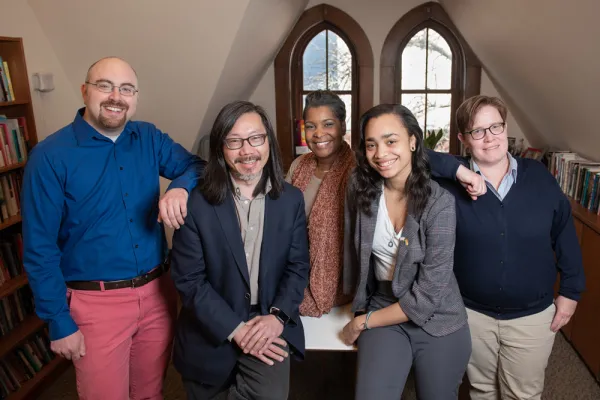‘A Community that Cares’: Inclusion in Action
Campus Life

Published April 27, 2020
What does Inclusion in Action mean at Smith?
It’s the banner for continuing efforts to make the campus more equitable and welcoming, says Floyd Cheung, Smith’s vice president for equity and inclusion and a professor of English language and literature.
Last year’s April 10 Day of Learning led to new initiatives on that front—including the revival of the college’s Inclusion Council and creation of action teams to address areas of need.
This week, Cheung’s office posted a one-year update to share progress made since last year’s daylong conference—including the work of action teams that will “inform the emergent strategic plan for advancing equity and inclusion at Smith,” Cheung says.
Earlier this spring, members of Cheung’s staff reflected on the progress of equity and inclusion efforts at Smith. Participants included Tobias Davis, inclusion education trainer/facilitator; Raven Fowlkes-Witten, program and outreach coordinator; Amy Hunter, director of equal opportunity and Title IX compliance; Queen Lanier, assistant to the vice president for equity and inclusion; and Inclusion in Action team member Annie Delbusto Cohen, leadership development designer for the Wurtele Center for Leadership.
Here’s what they had to say.
What’s the most important thing for college community members to know about inclusion and equity initiatives at Smith?
Floyd Cheung: “We’ll continue to apply a growth mindset to our work—knowing that we will sometimes face setbacks but are always seeking improvement. Lots of students, staff and faculty care about this work and are willing to help.”
Raven Fowlkes-Witten: “One of the great things that people will see in our update is links to past and present recipients of the president’s Innovation Challenge grants, where people can find information about the impact of those projects on campus.”
Cheung: “Even COVID-19 hasn’t stopped them. Despite disruptions, the challenge grant groups have done remarkably creative work, and in some cases, have been able to secure continuing funding. The hope is that through these examples, people will learn some of the breadth of what’s going on and see the continued momentum for change.”
What’s different about the equity and inclusion work now underway at Smith?
Toby Davis: “There’s an energy that’s spreading across the community. I’ve been affiliated with Smith for 20 years, and this feels like a time when people are really communicating and coming out of their silos. The action teams are a mix of faculty, staff and students who are all collaborating on these issues. It feels really exciting!”
Amy Hunter: “We’re building our capacity to be informed and also engaging differently with each other. The action teams are a vehicle for creating inclusion across difference. When people said we don’t want April 10, 2019 to be a one-off—we heard you.”
What are some signs of progress toward making Smith a more welcoming campus?
Hunter: “One important thing is that we’ve expanded the staff of our office with a trainer/facilitator and an outreach program coordinator to liaison with undocumented, trans and gender non-conforming students. We have people who can do the work we need to have done.”
Cheung: “We are also forming new alliances, including with academic departments, the Wurtele Center and Dining Services. We’ve studied the data from last year’s Day of Learning, the student demands of April 11, and the previous Pathways survey, so we have an idea of what the community needs.”
Annie Cohen: “I think the action teams are a big accomplishment and show a different hope and model for leadership. People who don’t typically work together are collaborating and having fruitful dialogue.”
What’s a key challenge facing inclusion and equity work at Smith?
Davis: “An ongoing challenge of doing this work is reaching the people who don’t engage because they think equity and inclusion has nothing to do with them. And the second group, who maybe can’t get release time to be on a committee or, because of the structures of Smith, can’t engage as easily.”
Queen Lanier: “The biggest challenge is just individuals making a choice to become committed to changing the norms—the way things have always been done. Our team has been leaning in to communicating as a way of building hope and trust. We want people to know that we haven’t dropped the ball on inclusion and equity; that we care.”
What are some strengths that the Smith community brings to equity and inclusion efforts?
Fowlkes-Witten: “We have a community that cares.”
Cohen: “Also this is a shared effort. It’s not just the Office for Inclusion and Equity doing this work. So many people are involved. One of the major concerns we heard from last year is that a lot of people wanted immediate changes on campus. We hope our update will help people to see inclusion work as a process that they can be involved in.’’
Pictured: Staff members of the Office for Equity and Inclusion on campus in early March.